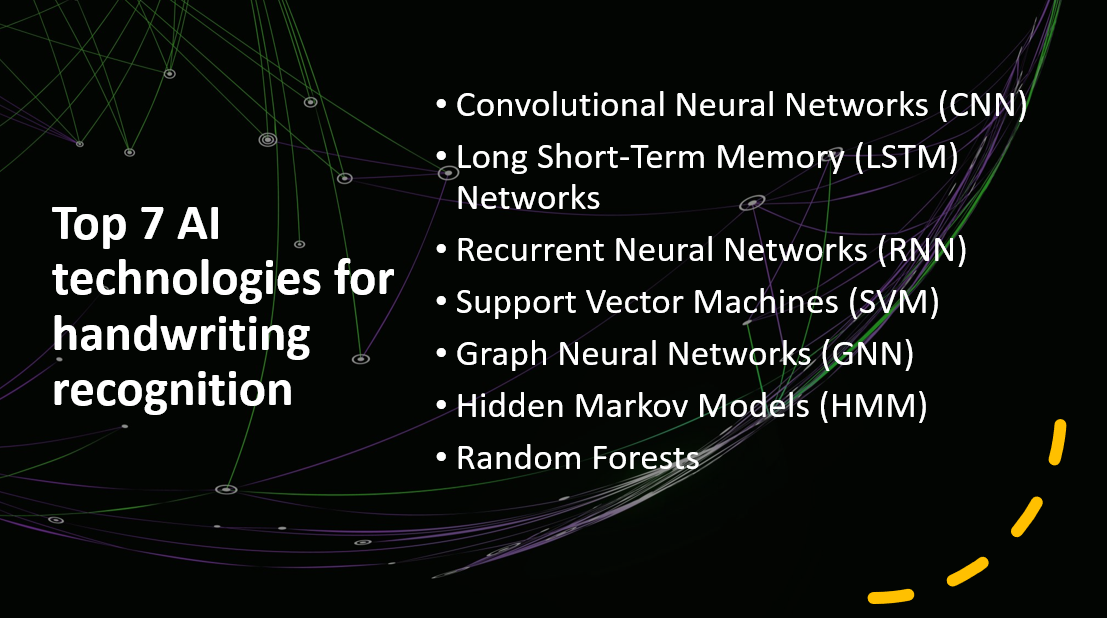
Introduction
Handwriting recognition technology has made significant strides in recent years, transforming the way we interact with digital devices and enabling efficient digitization of handwritten content.
Artificial Intelligence (AI) technologies have played a pivotal role in advancing handwriting recognition capabilities, making it possible to convert handwritten text into machine-readable format accurately.
In this blog post, we will explore the top seven AI technologies for handwriting recognition and their contributions to various applications.
Why use AI technologies for handwriting recognition?
- AI algorithms can accurately recognize and interpret handwritten text, even with variations in handwriting styles and quality.
- AI technologies automate the process of handwriting recognition, enabling fast and efficient conversion of handwritten text into digital format.
- AI can recognize handwriting in various languages, making it suitable for multilingual applications and document analysis.
- AI algorithms can be trained and fine-tuned to recognize specific handwriting styles or individual handwriting patterns, improving recognition accuracy.
Related Reading:
Here Are Our Top 7 AI technologies for handwriting recognition:
1: Convolutional Neural Networks (CNN)
Overview and Importance
Convolutional Neural Networks (CNN) are a fundamental AI technology that plays a critical role in handwriting recognition. CNNs excel at extracting features from images, making them well-suited for analyzing and recognizing handwritten text. By leveraging their hierarchical structure and convolutional layers, CNNs can capture local patterns and global relationships in handwriting images, leading to more accurate recognition.
Key Features and Capabilities
Architectures
- CNN-based architectures such as LeNet and AlexNet have proven effective in handwritten recognition tasks. With their convolutional and fully connected layers, these architectures learn and extract features from handwritten images.
Character Segmentation
- Handwriting recognition involves segmenting individual characters from handwritten text using techniques like connected component analysis and contour extraction.
Feature Extraction and Sequence Modeling
- CNNs extract relevant features from segmented characters and capture temporal dependencies in handwriting sequences by combining with RNNs or LSTM networks.
2: Long Short-Term Memory (LSTM) Networks
Overview and Importance
Long Short-Term Memory (LSTM) networks are a type of recurrent neural network (RNN) that have demonstrated significant importance in the field of handwriting recognition. LSTMs are designed to capture long-term dependencies in sequential data and are particularly effective in recognizing and understanding the complex patterns and structures present in handwritten text. Their ability to model sequential information and handle variable-length inputs makes them well-suited for handwriting recognition tasks.
Key Features and Capabilities
Sequence Modeling
- LSTMs excel at modeling sequential data, allowing them to capture the temporal dependencies present in handwritten text. This enables them to learn and recognize patterns and structures in handwriting.
Memory Cells
- LSTMs contain memory cells that can retain information over long sequences, making them well-suited for handling the varying stroke lengths and writing styles observed in handwritten text.
Robustness to Variability
- LSTMs are capable of accommodating variations in handwriting styles, slant, stroke width, and other factors that contribute to the uniqueness of handwritten text, allowing for accurate recognition across diverse samples.
Related Reading:
3: Recurrent Neural Networks (RNN)
Overview and Importance
Recurrent Neural Networks (RNNs) are a class of neural networks that are widely used in the field of handwriting recognition. RNNs are designed to process sequential data by incorporating feedback connections, allowing them to capture the temporal dependencies present in handwritten text. Their ability to model context and sequential information makes them well-suited for tasks such as handwriting recognition, where the order of the strokes or characters is crucial.
Key Features and Capabilities
Sequential Modeling
- RNNs can effectively model sequential data, enabling them to capture the temporal dependencies and patterns in handwriting strokes or characters. This makes them suitable for recognizing and understanding the sequential nature of handwritten text.
Context Preservation
- RNNs have the capability to retain information from previous steps or time points, allowing them to maintain context and consider the entire sequence when making predictions. This is particularly beneficial in handwriting recognition, where the context of previous strokes is crucial for accurate interpretation.
Variable-Length Inputs
- RNNs can handle variable-length sequences, making them flexible in handling different lengths of handwritten text. This adaptability is important in recognizing and interpreting handwriting samples of varying lengths and complexities.
4: Support Vector Machines (SVM)
Overview and Importance
Support Vector Machines (SVM) is a popular machine learning algorithm that has been successfully applied to various tasks, including handwriting recognition. SVM is a supervised learning model that learns to classify data points by finding an optimal hyperplane that maximally separates different classes. In the context of handwriting recognition, SVM can be used to classify handwritten characters or words based on their features.
Key Features and Capabilities
Non-Linear Classification
- SVMs can effectively classify nonlinear data by using kernel functions that map the input data into higher-dimensional feature spaces. This allows SVMs to capture complex patterns and make accurate predictions in handwriting recognition tasks.
Margin Maximization
- SVM aims to find a hyperplane that maximizes the margin between different classes, which promotes better generalization and robustness. This can lead to improved performance in recognizing and distinguishing different handwriting styles or characters.
Support for High-Dimensional Data
- SVMs can handle high-dimensional feature spaces, making them suitable for handwriting recognition tasks that involve extracting multiple features from handwritten samples. SVMs can effectively learn and classify data points in high-dimensional spaces, leading to accurate recognition results.
Related Reading:
5: Hidden Markov Models (HMM)
Overview and Importance
Hidden Markov Models (HMMs) are probabilistic models that have been widely used in various fields, including handwriting recognition. HMMs are particularly useful in capturing sequential dependencies and modeling dynamic processes. In the context of handwriting recognition, HMMs can be used to model the temporal evolution of handwriting strokes and capture the underlying patterns and transitions between different states.
Key Features and Capabilities
Sequence Modeling
- HMMs excel at modeling sequential data, making them suitable for handwriting recognition tasks that involve analyzing the temporal order of strokes or characters. HMMs can capture the transition probabilities between different states, allowing for the recognition of handwriting patterns.
Probabilistic Framework
- HMMs provide a probabilistic framework for modeling uncertainties and variations in handwriting. They can handle different levels of uncertainty in the observed data and make informed decisions based on the probability distributions of different states.
Training and Inference
- HMMs can be trained using the Baum-Welch algorithm, which estimates the model parameters from training data. Once trained, HMMs can perform inference to recognize handwriting patterns and generate most likely sequences of states or characters given the observed data.
6: Random Forests
Overview and Importance
Random Forests is an ensemble learning method that combines multiple decision trees to improve accuracy and robustness in various tasks, including handwriting recognition. Random Forests are known for their versatility, ease of use, and effectiveness in handling complex data patterns. In the context of handwriting recognition, Random Forests can be employed to extract relevant features from input images and make accurate predictions based on the collective decisions of multiple decision trees.
Key Features and Capabilities
Ensemble Learning
- Random Forests utilize ensemble learning by combining multiple decision trees, each trained on a different subset of the data, to make predictions. This aggregation of individual tree predictions helps reduce overfitting and improve generalization performance.
Feature Importance
- Random Forests provide a measure of feature importance, indicating which features contribute the most to the prediction. This information can be valuable in understanding the relevance of different input features in handwriting recognition tasks.
Robustness to Noise and Outliers
- Random Forests are robust to noise and outliers in the data due to their averaging effect. By aggregating predictions from multiple decision trees, Random Forests can handle variations in handwriting strokes and patterns, making them suitable for real-world scenarios with diverse handwriting styles.
Related Reading:
7: Graph Neural Networks (GNN)
Overview and Importance
Graph Neural Networks (GNNs) are a class of neural network models specifically designed to operate on graph-structured data. They are particularly relevant in the context of handwriting recognition as they can capture the structural relationships and dependencies between handwritten characters or strokes. GNNs enable the modeling of complex interactions and dependencies within a graph, making them suitable for tasks that involve analyzing relationships between elements in a handwriting dataset.
Key Features and Capabilities
Graph Representation
- GNNs can represent handwriting data as a graph, with characters or strokes as nodes and their relationships as edges. This allows GNNs to capture the structural properties of handwriting and leverage them for recognition tasks.
Message Passing
- GNNs use message passing algorithms to propagate information through the graph. Nodes exchange information with their neighboring nodes, allowing the network to gather and aggregate information from the entire graph.
Hierarchical Representation Learning
- GNNs can learn hierarchical representations of the graph data by aggregating information from local to global levels. This allows them to capture complex patterns and dependencies within the handwriting data.
Conclusion
AI technologies play a significant role in handwriting recognition by accurately interpreting handwritten text. The top seven AI technologies for handwriting recognition are Convolutional Neural Networks (CNN), Long Short-Term Memory (LSTM) Networks, Recurrent Neural Networks (RNN), Support Vector Machines (SVM), Hidden Markov Models (HMM), Random Forests, and Graph Neural Networks (GNN).
These technologies have key features, capabilities, and advantages in accurately recognizing handwritten text:
- Convolutional Neural Networks (CNN): Powerful models for image analysis, extracting features from handwriting images.
- Long Short-Term Memory (LSTM) Networks: Specialized in capturing long-term dependencies in sequential data, suitable for handwriting recognition.
- Recurrent Neural Networks (RNN): Designed to process sequential data, enabling modeling of handwriting patterns and context.
- Support Vector Machines (SVM): Effective in binary classification tasks, learning decision boundaries for handwriting recognition.
- Hidden Markov Models (HMM): Probabilistic models capturing temporal dependencies in sequential data, applicable to stroke sequence analysis.
- Random Forests: Ensemble learning models handling high-dimensional data, achieving good accuracy in handwriting recognition.
- Graph Neural Networks (GNN): Specialized for structured data, applicable to handwritten graphs such as mathematical equations.
Handwriting recognition has a significant impact on digitalization, document processing, and accessibility. It enables the conversion of handwritten documents into digital formats, automates information extraction from forms, and enhances accessibility for individuals with limited motor skills or visual impairments.
Further research and development in AI-driven handwriting recognition are encouraged to advance its accuracy and usability. Continued innovation in this field will contribute to broader digitalization, efficient document processing, and increased inclusivity in accessing and utilizing handwritten information.
